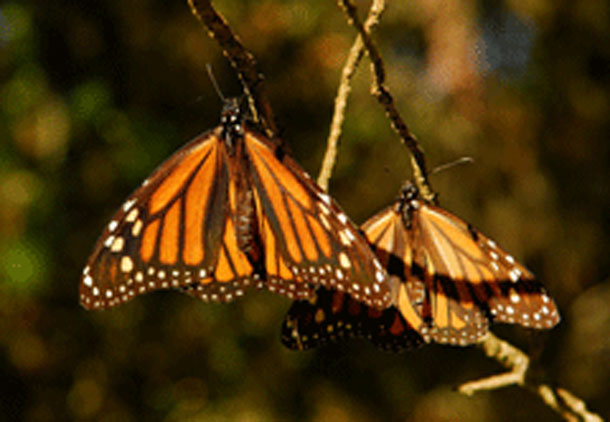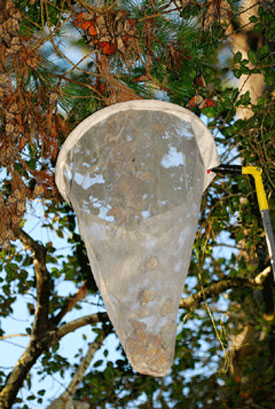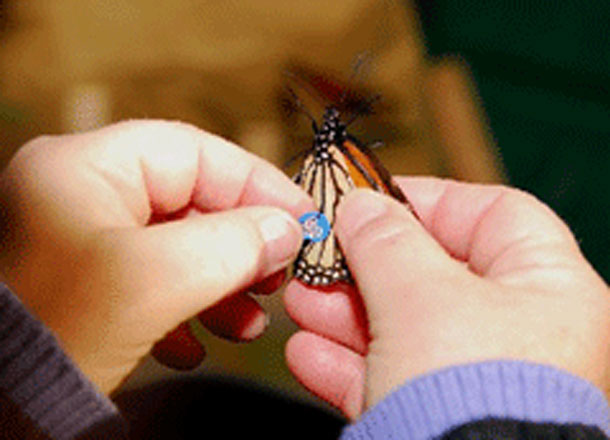Taggers at Work
Air Date: Week of July 26, 2019

Monarchs (Photo: Tom Moss, CA State Parks)
Western monarch butterflies migrate, but biologists don't know exactly where they go when they leave the winter warmth of coastal California. Reporter Rachael McDonald spent a day with biologists who are trying to find out.
Transcript
BASCOMB: The vast majority of Eastern monarchs spend the winter in the Sierra Madre Mountains of Mexico. But western monarchs, those that migrate west of the Rocky Mountains, overwinter on the coast of California and fan out from there across the West each summer. The problem is, wildlife biologists don’t know precisely where all those butterflies go, so they don’t know which places to protect. To figure that out, some Western monarchs are being captured and tagged, so biologists can track them. But how do you tag the delicate wings of a butterfly? Very carefully, as reporter Rachael McDonald found in 2007 when she tagged along with biologists in the town of Pacific Grove, on Monterey Bay.
McDONALD: Pacific Grove's George Washington Park is a shady grove of trees on the edge of a quiet residential street. Here, on a cool late winter morning, wildlife biologist Jessica Griffiths is reaching high into a live oak tree with a 15-foot pole with a net on the end. She's shaking the pole.
GRIFFITHS: Okay. So, you can see they're really cold, they’re not moving very much.
McDONALD: The monarchs are all clustered together at the end of a branch.
[SHAKING SOUND]
GRIFFITHS: Rise and shine!
McDONALD: Griffiths shakes the butterflies into the net and then lowers it, and with the help of a volunteer, carefully pours the insects into a paper bag.
[MONARCHS GO INTO THE BAG]
McDONALD: Griffiths instructs the six volunteers helping her tag monarchs today. They're sitting on folding chairs in the middle of the forest. Each pair has a bag full of untagged butterflies and another bag for tagged ones.
OLSEN: Female.
McDONALD: One at a time, intern Jen Olsen takes a butterfly out of the bag, identifies it as male or female, then gently attaches a tiny fingertip-sized sticker to the underside of its wing. She's careful not to touch the top part of the wings where delicate, brightly colored scales could be rubbed off. Another volunteer notes the insect's gender on a data sheet.

Monarchs are captured using a net on a pole that extends 25 feet up to where the butterflies are hanging. (Photo: Tom Moss, CA State Parks)
This is a pilot program of the Ventana Wildlife Society, a local non-profit funded by donations and grants. Biologist Jessica Griffiths says the goal is to understand two things about the monarchs that come here. One, where do the butterflies go during the winter?
GRIFFITHS: Butterflies come to specific places on the California coast to spend the winter and we have actually long suspected that they probably move around during the winter between over-wintering sites; however, that's very hard to tell when the butterflies are not marked in any way because all the butterflies look the same.
McDONALD: Each tag has a toll-free number and a tracking number for the particular butterfly. Several months ago, Griffiths' team tagged about a thousand butterflies. A few weeks later she got a call from someone who found a tagged one up north near Santa Cruz. Another was found in Big Sur, more than 40 miles south of here.
GRIFFITHS: Just that data alone made the tagging worthwhile because we really didn't have any idea that they could move so far so quickly.
McDONALD: Griffiths hopes this information helps conserve western monarch habitat up and down the central coast. That habitat is disappearing.
GRIFFITHS: We can't just, you know, protect, for example, the monarch sanctuary in Pacific Grove and think, well that's one spot, that's enough for them. We need to try and conserve as much habitat as we can.
McDONALD: Then, she says, once the monarchs leave for the spring and summer months, she hopes the tags will show her exactly where they go.
GRIFFITHS: What they do is they're going to all mate together in sort of a big frenzy, and then they leave the central coast and then they disperse inland in order to find milkweed, which is their host plant. But we don't know exactly where the butterflies from Pacific Grove go. Do they mostly go north or south or -- where do they go?
McDONALD: The Ventana Wildlife Society had to get special permission from the city council to tag the butterflies. A local ordinance makes it illegal to touch or bother a monarch butterfly. Anyone who does so gets fined a thousand dollars. Once a bag full of monarchs is tagged, they can be released. The team puts bags of butterflies in the sun on folding chairs so they can warm up.
[BUTTERFLIES MOVING IN THE BAG]
McDONALD: The butterflies are fluttering their wings. Nelly Thorngate, another wildlife biologist with Ventana says when the monarchs warm up, their circulation starts up.

This small sticker is placed on the monarch’s wing. (Photo: Tom Moss, CA State Parks)
THORNGATE: You can see them do this in the trees too, at about this time when the sun starts to hit the trees, they'll open up in their clusters and start to shiver as a bunch. What's neat is that they seem to hit a critical mass like that where they'll all shiver and kind of open their wings and be hanging out, and then all of a sudden everyone will take off at once, and it's amazing to see.
McDONALD: But here Thorngate and Griffiths let the insects go, one at a time.
GRIFFITHS: Would you like to release one?
McDONALD: Griffiths addresses a young volunteer, a little girl with her father, helping.
GRIFFITHS: Okay, so what you're going to do is you're going to hold him. I'm going to pass him to you and you're going to hold him with the wings closed and you're going to go like this, and when your hand is up high, that's when you're going to let him go, okay? There you go!
McDONALD: And the monarch takes off.
GRIFFITHS: [LAUGHS] Whoa, let's see if he can do it. All right, there he goes!
McDONALD: They’ll follow the milkweed, fanning out across the West.
BASCOMB: That report from Rachael McDonald came to us courtesy of KAZU in Monterey, California.
Links
Living on Earth wants to hear from you!
Living on Earth
62 Calef Highway, Suite 212
Lee, NH 03861
Telephone: 617-287-4121
E-mail: comments@loe.org
Newsletter [Click here]
Donate to Living on Earth!
Living on Earth is an independent media program and relies entirely on contributions from listeners and institutions supporting public service. Please donate now to preserve an independent environmental voice.
NewsletterLiving on Earth offers a weekly delivery of the show's rundown to your mailbox. Sign up for our newsletter today!
 Sailors For The Sea: Be the change you want to sea.
Sailors For The Sea: Be the change you want to sea.
 The Grantham Foundation for the Protection of the Environment: Committed to protecting and improving the health of the global environment.
The Grantham Foundation for the Protection of the Environment: Committed to protecting and improving the health of the global environment.
 Contribute to Living on Earth and receive, as our gift to you, an archival print of one of Mark Seth Lender's extraordinary wildlife photographs. Follow the link to see Mark's current collection of photographs.
Contribute to Living on Earth and receive, as our gift to you, an archival print of one of Mark Seth Lender's extraordinary wildlife photographs. Follow the link to see Mark's current collection of photographs.
 Buy a signed copy of Mark Seth Lender's book Smeagull the Seagull & support Living on Earth
Buy a signed copy of Mark Seth Lender's book Smeagull the Seagull & support Living on Earth

